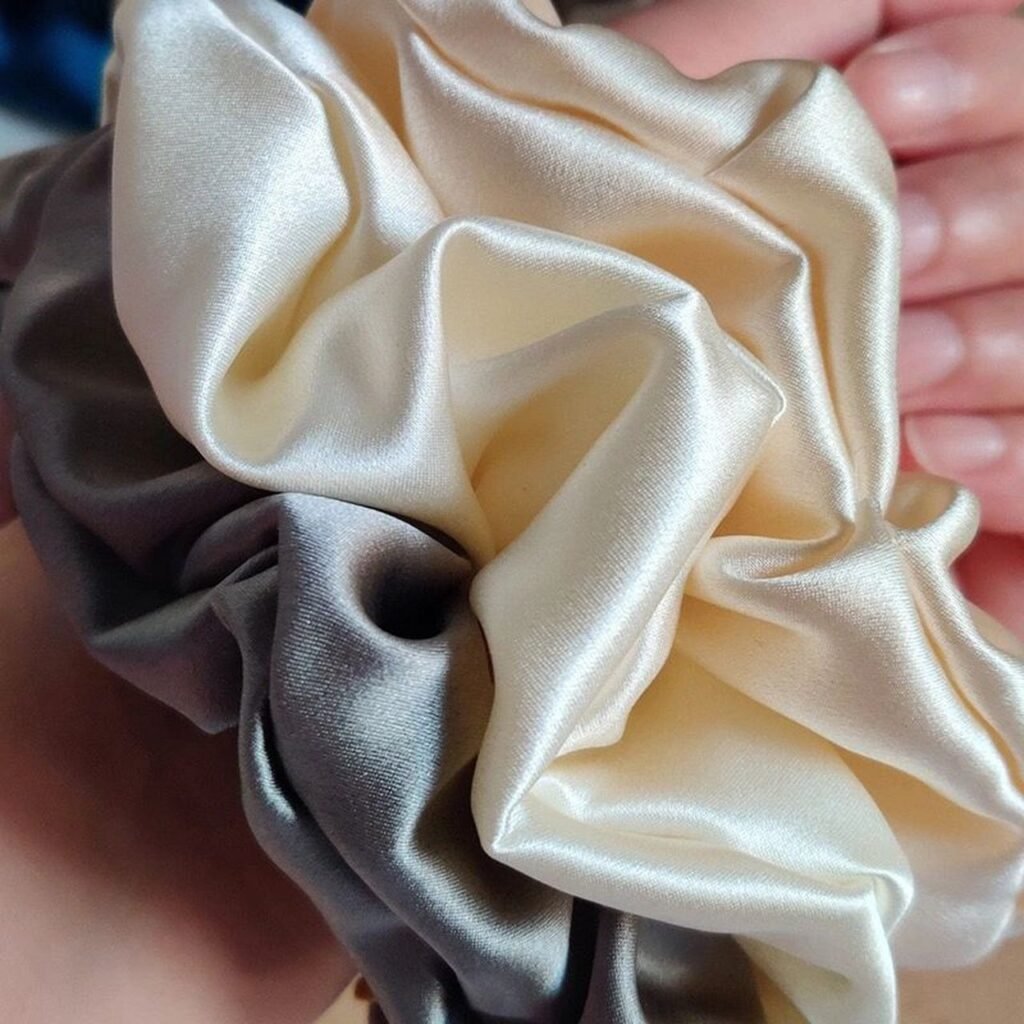
Imagine standing on the factory floor, bolts of cloth towering above you like city skyscrapers. Each roll promises potential—durability for workwear, softness for home décor, moisture-wicking for athletic gear. But with hundreds of fiber and construction options, how do you decide which fabric best suits your product? Fabric categories fall into broad groups—natural, synthetic, blends, and nonwovens—each engineered for specific performance criteria, from breathability and strength to cost and sustainability. Ready to demystify the textile spectrum? Let’s dive in—first up, the major fabric families and their go-to industrial uses.
What Are the Major Fabric Categories and Their Primary Industrial Applications?
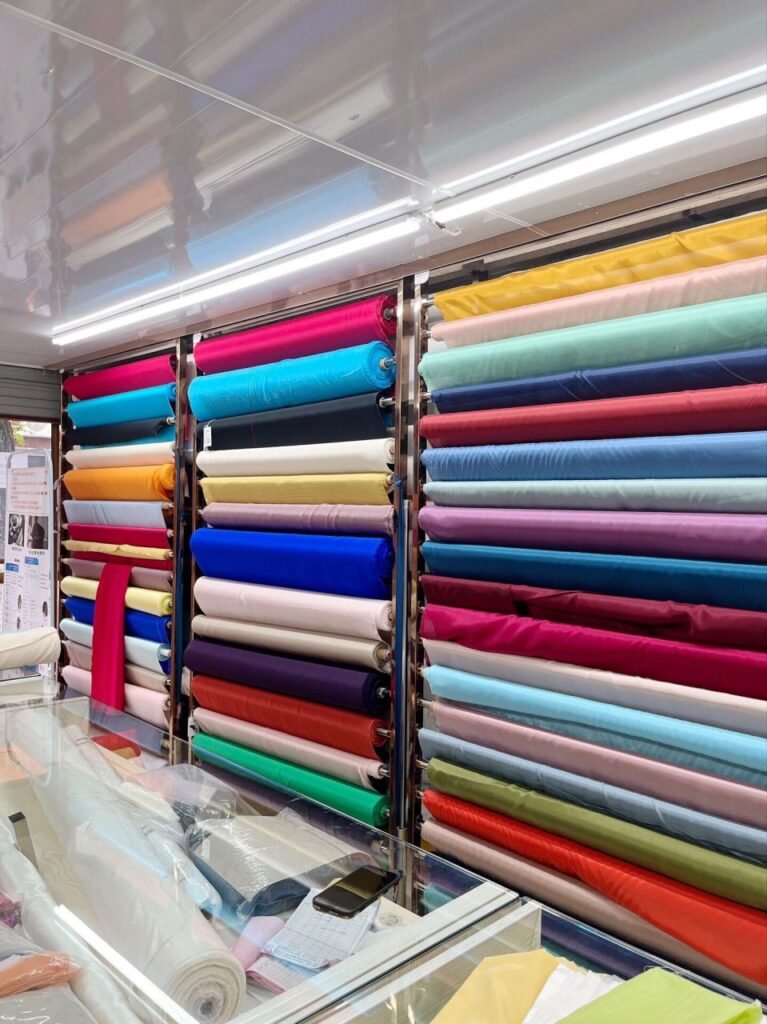
Fabric falls into four core categories—natural, synthetic, blended, and nonwoven—with each group tailored to different performance needs. Natural fibers like cotton and linen dominate in apparel and home textiles for their comfort and biodegradability. Synthetics such as polyester and nylon lead in technical applications—automotive upholstery, geotextiles, and outdoor gear—thanks to superior strength and weather resistance. Blended fabrics merge traits (e.g., poly-cotton work shirts), while nonwovens (e.g., polypropylene filter media) excel in disposable or high-filtration roles.
Comparing Fabric Categories
A. Natural Fibers
- Cotton & Linen: High moisture absorbency (6–8% MC), soft hand; ideal for apparel, bedding, upholstery.
- Silk & Wool: Excellent insulation and drape; used in luxury fashion and performance outerwear.
B. Synthetic Fibers
- Polyester & Nylon: Tensile strength > 3,000 N, low moisture regain (<1%), UV stable; used in automotive interiors, awnings, and technical workwear.
- Acrylic & Spandex: Abrasion-resistant, elastic; popular for knits, activewear, and upholstery stretch panels.
C. Blended Fabrics
- Poly-Cotton (65/35): Combines cotton’s comfort with polyester’s durability; ubiquitous in uniforms and household linens.
- Wool-Nylon: Enhances abrasion resistance for upholstery and outerwear.
D. Nonwovens
- Spunbond & Meltblown Polypropylene: Filtration efficiency > 95% at 0.3 µm; core in medical masks and industrial filters.
- Needle-Punched Felts: High thickness and bulk; used in geotextiles, insulation mats, and automotive soundproofing.
Overview of Fabric Categories and Key Metrics
| Category | Fiber Examples | Moisture Regain (%) | Tensile Strength (N) | Typical Uses |
|---|---|---|---|---|
| Natural | Cotton, Linen, Wool | 4–18 | 500–1,500 | Apparel, bedding, upholstery |
| Synthetic | Polyester, Nylon | <1 | 2,000–4,000 | Technical gear, automotive, awnings |
| Blends | Poly-Cotton, Wool-Nylon | 1–5 | 1,000–3,000 | Uniforms, linens, workwear |
| Nonwoven | PP, PET, Rayon Felts | N/A | 200–800 | Filters, hygiene, geotextiles, insulation |
Critical Perspectives
- Performance vs. Sustainability Naturals excel in biodegradability but demand more water; synthetics save water but rely on fossil feedstocks.
- Cost vs. Longevity Blends often hit the sweet spot for lifecycle value—lower cost than pure synthetics, higher durability than naturals.
- Technical vs. Aesthetic Needs Nonwovens deliver unmatched filtration but lack hand appeal—balance functionality with consumer expectations.
Which Natural Fibers—Such as Cotton, Linen, and Silk—Offer the Best Balance of Performance and Sustainability?
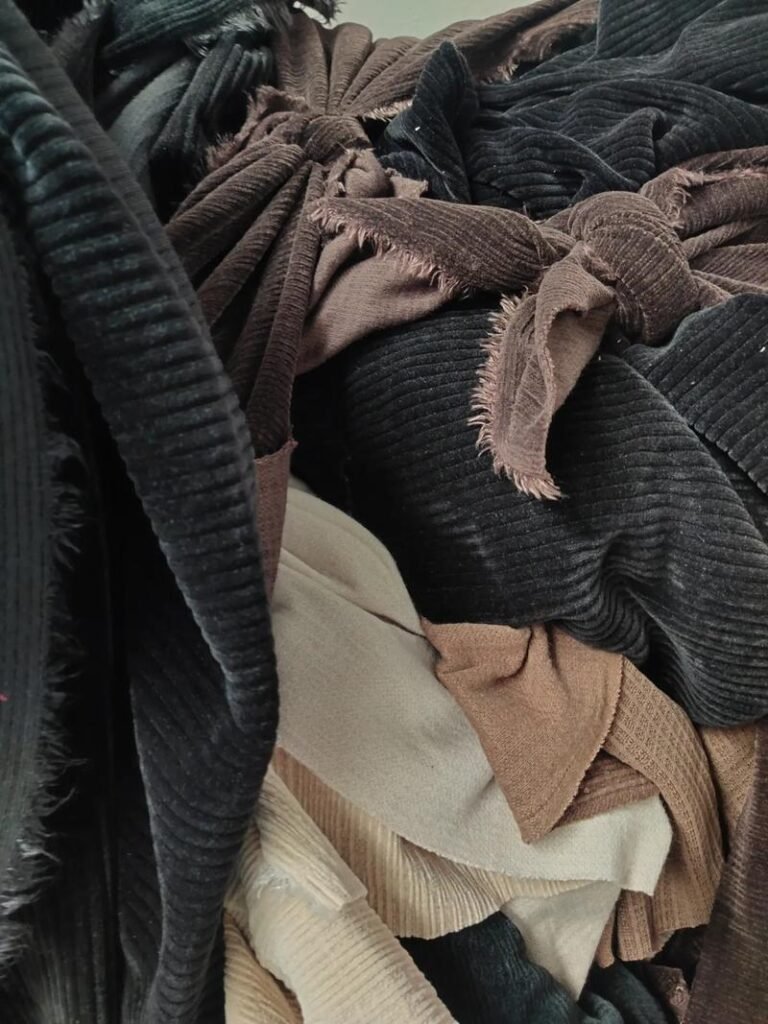
Natural fibers remain a cornerstone of textile sourcing because they marry comfort, breathability, and biodegradability. Cotton stands out for its softness, moisture management, and dye versatility, making it ideal for apparel and home textiles; linen boasts exceptional strength, cool-hand feel, and low environmental impact thanks to minimal irrigation needs; silk offers unmatched drape, thermal regulation, and luxury appeal despite higher cost and more intensive processing. Each fiber’s unique profile—tensile strength, moisture regain, environmental footprint—helps sourcing managers match fabric to application and brand values.
Evaluating Key Natural Fiber Attributes
A. Cotton: The Workhorse of Textiles
- Performance: Moisture regain \~8.5%, tensile strength 400–600 N, wrinkle-prone but soft hand.
- Sustainability: Conventional cotton uses \~10,000 L water/kg; organic cotton reduces pesticide load by 90%.
- Applications: T-shirts, denim, bedding, towels, and custom home décor.
B. Linen: The Eco-Friendly Strength Champion
- Performance: Moisture regain \~12%, tensile strength 600–800 N, naturally anti-bacterial and UV-resistant.
- Sustainability: Flax (linen source) requires 50–80% less water than cotton and minimal fertilizers.
- Applications: Summer apparel, upscale upholstery, industrial filtration, and tea towels.
C. Silk: The Luxurious Thermal Regulator
- Performance: Moisture regain \~11%, tensile strength 500–700 N, excellent sheen and drape.
- Sustainability: Lower land use than cotton but energy-intensive reeling and degumming; biodegradable.
- Applications: High-end fashion, bridal wear, luxury bedding, and acoustic panels.
D. Emerging Natural Options
- Bamboo Viscose: High moisture wicking (\~11%), natural antimicrobial, moderate strength (400–500 N), sustainability varies by process.
- Hemp: High tensile strength (800–1,200 N), moisture regain \~12%, biodegradable, often blended for softness.
Natural Fiber Comparison
| Fiber | Tensile Strength (N) | Moisture Regain (%) | Water Use (L/kg) | Biodegradability | Key Benefits |
|---|---|---|---|---|---|
| Cotton | 400–600 | 8.5 | 10,000–20,000 | Yes (2–5 yrs) | Softness, dyeability, low cost |
| Linen | 600–800 | 12 | 2,000–5,000 | Yes (1–2 yrs) | Strength, breathability, eco-friendly |
| Silk | 500–700 | 11 | 5,000–10,000 (energy) | Yes (2–3 yrs) | Luster, drape, thermal regulation |
| Bamboo | 400–500 | 11 | 2,000–5,000 (variable) | Yes (2–3 yrs) | Antimicrobial, wicking |
| Hemp | 800–1,200 | 12 | 1,000–3,000 | Yes (1–2 yrs) | Durability, UV resistance |
Critical Perspectives
- Water Footprint vs. Performance Cotton’s ubiquitous use contrasts sharply with its high irrigation needs—organic or rain-fed cotton can mitigate this, while linen offers superior performance with a fraction of water.
- Softness vs. Durability Cotton’s hand feel is unmatched, but linen and hemp deliver longer garment life. Blends of cotton and linen can strike a balance, improving durability without sacrificing comfort.
- Process Sustainability Viscose from bamboo can be eco-friendly or chemical-intensive depending on the pulping method—look for closed-loop certifications (e.g., FSC or OEKO-TEX®).
- Market Perception and Price Silk commands a luxury premium, limiting its use to high-margin products, whereas cotton and linen serve mass and niche markets more cost-effectively.
How Do Synthetic Fabrics Like Polyester, Nylon, and Acrylic Compare in Terms of Durability, Cost, and Functional Properties?
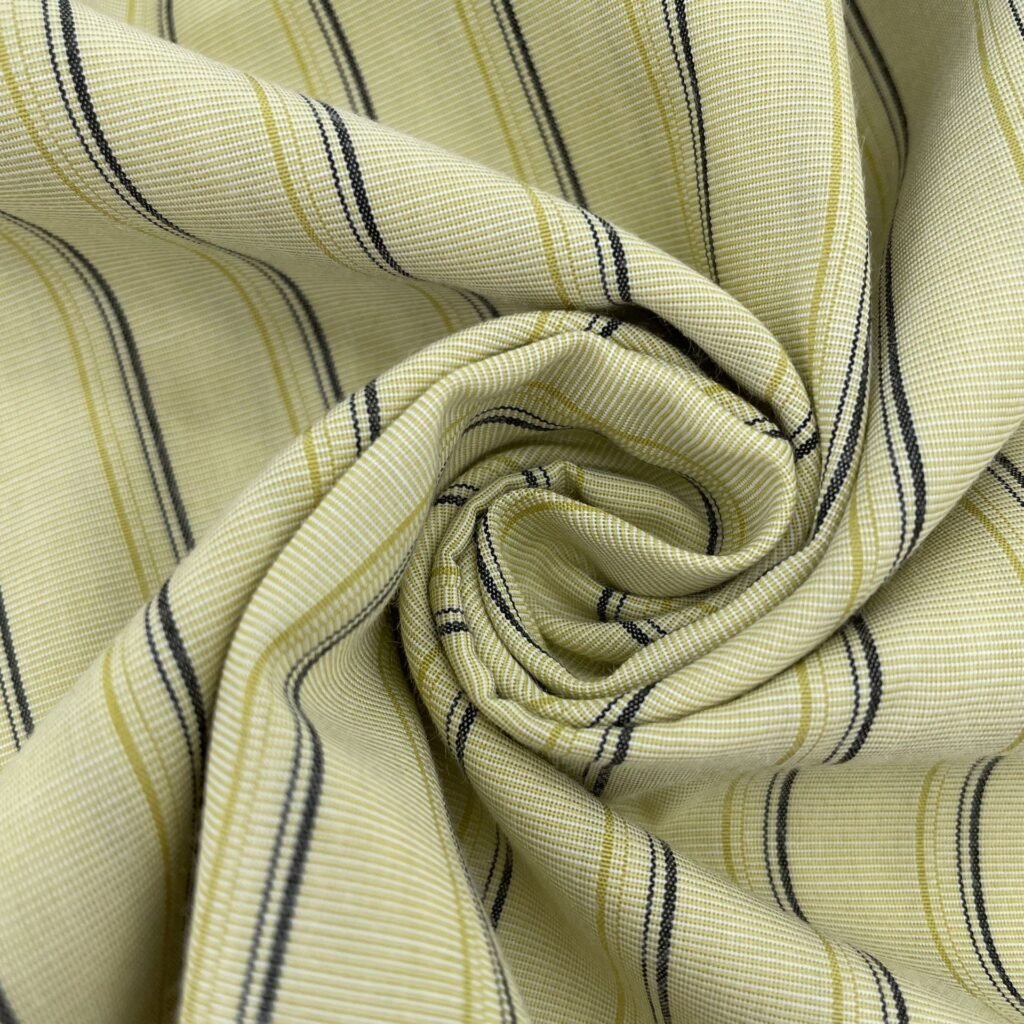
Synthetic fibers revolutionized textiles by offering high strength, low cost, and specialized functions. Polyester excels in UV resistance and moisture-wicking, costing \$1.50–\$3.00 per kilogram; nylon boasts superior abrasion resistance and elasticity—ideal for industrial belting—at \$2.00–\$4.00 per kilogram; acrylic offers wool-like warmth and colorfastness for \$2.50–\$3.50 per kilogram but is less durable under heavy mechanical stress. These cost–performance profiles guide sourcing managers when specifying fabrics for everything from outdoor gear to automotive interiors.
Synthetic Fiber Trade-Offs and Use Cases
A. Polyester (PET)
- Durability: Tensile strength 2,500–4,000 N; abrasion resistance > 50,000 rubs.
- Functional: Low moisture regain (<0.5%), quick-drying, UV stability >1,000 hours.
- Cost & Sustainability: \$1.50–\$3.00/kg; readily recycled (rPET) but sheds microfibers in wash.
B. Nylon (Polyamide)
- Durability: Tensile strength 3,000–5,000 N; excellent tear resistance (tear strength 800–1,200 N).
- Functional: High elasticity (elongation 20–30%), good chemical resistance, moderate UV stability (500–700 hours).
- Cost & Sustainability: \$2.00–\$4.00/kg; energy-intensive production, limited recycling streams.
C. Acrylic (PAN)
- Durability: Tensile strength 1,500–2,500 N; abrasion resistance 20,000–30,000 rubs.
- Functional: Moisture regain \~2%, wool-like warmth, exceptional dye uptake and colorfastness.
- Cost & Sustainability: \$2.50–\$3.50/kg; high dye-affinity but poor biodegradability.
D. Emerging Synthetics
- Polypropylene (PP): Low cost (\$1.00–\$2.00/kg), moisture-regain <0.1%, used in nonwovens and geotextiles.
- Elastane (Spandex): High elasticity (500–600% elongation), low strength (500–800 N), crucial for stretch applications.
Synthetic Fiber Performance and Costs
| Fiber | Tensile Strength (N) | Tear Strength (N) | Elongation (%) | UV Stability (hrs) | Cost (USD/kg) | Moisture Regain (%) |
|---|---|---|---|---|---|---|
| Polyester | 2,500–4,000 | 600–900 | 15–20 | 1,000–1,500 | 1.50–3.00 | <0.5 |
| Nylon | 3,000–5,000 | 800–1,200 | 20–30 | 500–700 | 2.00–4.00 | 4.0 |
| Acrylic | 1,500–2,500 | 400–600 | 15–25 | 800–1,000 | 2.50–3.50 | \~2 |
| Polypropylene | 1,000–1,500 | 200–400 | 10–15 | 200–400 | 1.00–2.00 | <0.1 |
| Elastane | 500–800 | 100–200 | 500–600 | N/A | 10.00–12.00 | N/A |
Critical Perspectives
- Cost vs. Performance While polyester offers the best balance of price and durability, nylon’s superior strength justifies its higher cost in heavy-duty uses.
- Recycling and Microplastics rPET addresses polyester’s environmental concerns, but microplastic shedding remains an issue—install filtration at wash facilities.
- Functional Trade-Offs Acrylic’s warmth and colorfastness come at the expense of lower mechanical strength—ideal for décor and knits, less so for abrasion-intensive workwear.
- Blend Opportunities Blending nylon with polyester can marry elasticity with UV stability, while polyester–elastane blends give stretch athletic fabrics both resilience and recovery.
What Benefits Do Blended Fabrics (e.g., Poly-Cotton, Wool-Nylon) Provide for Specific End Uses?
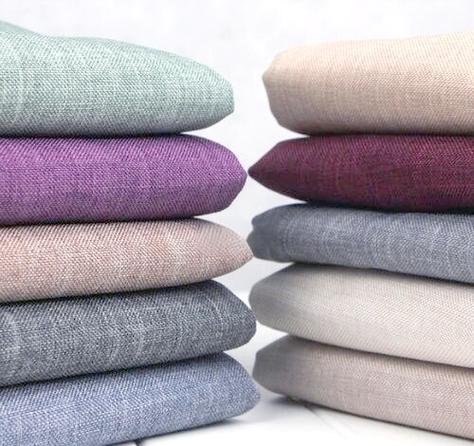
Blended fabrics combine fibers to marry strengths and mitigate weaknesses. Poly-cotton blends deliver cotton’s softness and breathability with polyester’s wrinkle resistance and durability, ideal for uniforms and home linens. Wool-nylon blends meld wool’s warmth and moisture control with nylon’s abrasion resistance and shape retention, perfect for outerwear and upholstery. These synergies yield fabrics that outperform pure yarns in comfort, longevity, and lifecycle value.
Blend Mechanics and Application Analysis
A. Poly-Cotton (65/35 or 50/50)
Performance:
- Wrinkle reduction: 50% less than 100% cotton
- Durability: 25% higher tensile strength than pure cotton
Applications:
- Work uniforms withstand 100+ wash cycles with minimal shrinkage (<2%).
- Bed linens combine softness for sleep comfort with easy care.
B. Wool–Nylon (80/20 or 70/30)
Performance:
- Abrasion resistance: 40,000 martindale rubs vs. 30,000 for 100% wool
- Dimensional stability: shrinkage < 3% after proper finishing
Applications:
- Technical outerwear resists tears and retains loft even when wet.
- High-traffic upholstery balances comfort with wear resilience.
C. Performance Blend Innovations
- Polyester–Elastane (95/5) for stretch activewear—offers 500% elongation with full recovery.
- Cotton–Modal (55/45) for luxury basics—enhanced drape and moisture wicking.
Blend Comparison and Use Cases
| Blend Type | Key Benefits | Typical Weight (oz/yd²) | Primary Uses |
|---|---|---|---|
| 65/35 Poly-Cotton | Soft hand + durability | 4–6 | Shirts, bed linens, napery |
| 50/50 Poly-Cotton | Balanced comfort + easy care | 6–8 | Uniforms, casual apparel |
| 80/20 Wool–Nylon | Warmth + abrasion resistance | 10–14 | Outerwear, upholstery |
| 95/5 Poly–Elastane | Stretch + shape retention | 6–10 | Activewear, stretch linings |
| 55/45 Cotton–Modal | Drape + moisture management | 4–6 | Luxury tees, intimate apparel |
Critical Perspectives
- Comfort vs. Durability Trade-Off Increasing synthetic content boosts strength but may diminish handfeel—select the right ratio to match end-user priorities.
- Care Requirements Blends often need specific wash temperatures to preserve both fiber types—uniforms may require industrial laundering protocols.
- Sustainability Considerations Blends complicate recycling; sourcing managers should partner with mills offering take-back or chemical recycling solutions.
- Cost Implications Blends can cost 10–20% more than pure cotton, but extended garment life and reduced replacement frequency often justify the premium.
Which Fabric Constructions—Woven, Knitted, and Nonwoven—Are Most Appropriate for Different Product Requirements?

Fabric construction dictates stretch, strength, porosity, and hand feel—key factors for sourcing managers. Woven fabrics (plain, twill, satin) deliver dimensional stability and strength, ideal for shirting, denim, and upholstery. Knitted structures (weft, warp) offer stretch and comfort, perfect for activewear, T-shirts, and seamless garments. Nonwovens (spunbond, meltblown, needle-punched) provide filtration, insulation, and disposable hygiene solutions. Matching construction to end use ensures product performance and cost-efficiency.
Construction Types and Performance Profiles
A. Woven Fabrics
- Attributes: Low stretch (2–5%), high tear strength (500–2,000 N), versatile drape.
Variants:
- Plain Weave: Balanced strength vs. light weight (e.g., poplin shirts).
- Twill Weave: Diagonal ribs, 30% higher abrasion resistance (e.g., denim).
- Satin Weave: Smooth surface, low friction (e.g., lining fabrics).
- Applications: Workwear, denim, drapery, technical canvas.
B. Knitted Fabrics
- Attributes: Stretch up to 100% (weft knits), rapid moisture wicking, comfortable.
Variants:
- Jersey Knit: Single-knit, moderate stretch, soft hand.
- Rib Knit: High recovery, body-contouring (e.g., cuffs).
- Interlock: Double-knit, stable, reversible.
- Applications: T-shirts, sportswear, undergarments, seamless outerwear.
C. Nonwoven Fabrics
- Attributes: Engineered porosity, bulk, and low cost per square meter.
Variants:
- Spunbond: Strong, lightweight; used for geotextiles and medical gowns.
- Meltblown: Ultra-fine fibers; core of N95 masks and industrial filters.
- Needle-Punched Felt: High loft and insulation; used for automotive sound dampening and geotextiles.
- Applications: Filters, hygiene, wipes, insulation, landscaping fabrics.
Construction Comparison and Typical Metrics
| Construction | Stretch (%) | Tear Strength (N) | Thickness (mm) | Typical End Uses |
|---|---|---|---|---|
| Plain Weave | 2–3 | 500–800 | 0.2–0.5 | Shirts, lightweight drapes |
| Twill Weave | 3–5 | 800–1,500 | 0.4–0.7 | Denim, workwear, upholstery |
| Satin Weave | 2–4 | 400–700 | 0.3–0.6 | Linings, formalwear |
| Jersey Knit | 50–100 | 300–500 | 0.5–1.0 | T-shirts, activewear |
| Rib Knit | 75–150 | 400–600 | 0.8–1.2 | Cuffs, collars, fitted garments |
| Spunbond | <5 | 200–400 | 0.1–0.3 | Nonwoven bags, gowns |
| Meltblown | <2 | 50–150 | 0.05–0.2 | Filters, masks |
| Needle-Punched | 0–5 | 300–700 | 1.0–5.0 | Insulation, geotextiles |
Critical Perspectives
- Stability vs. Comfort Wovens offer structure but limited give; knits maximize comfort yet can sag—choose based on garment fit and recovery needs.
- Cost vs. Functionality Nonwovens are cost-effective for disposables but unsuited for durable goods—reserve them for single-use or technical filter roles.
- Hybrid Constructions Lace-knits or jacquard wovens can blend aesthetics with function, but complexity raises production costs and lead times.
- Sustainability Angle Recycled fibers often perform differently in knits vs. weaves (e.g., recycled PET shows more pilling in jerseys)—prototype accordingly.
How Are Specialty Finishes (Waterproofing, Flame Retardancy, Antimicrobial) Applied, and What Impact Do They Have on Fabric Performance?
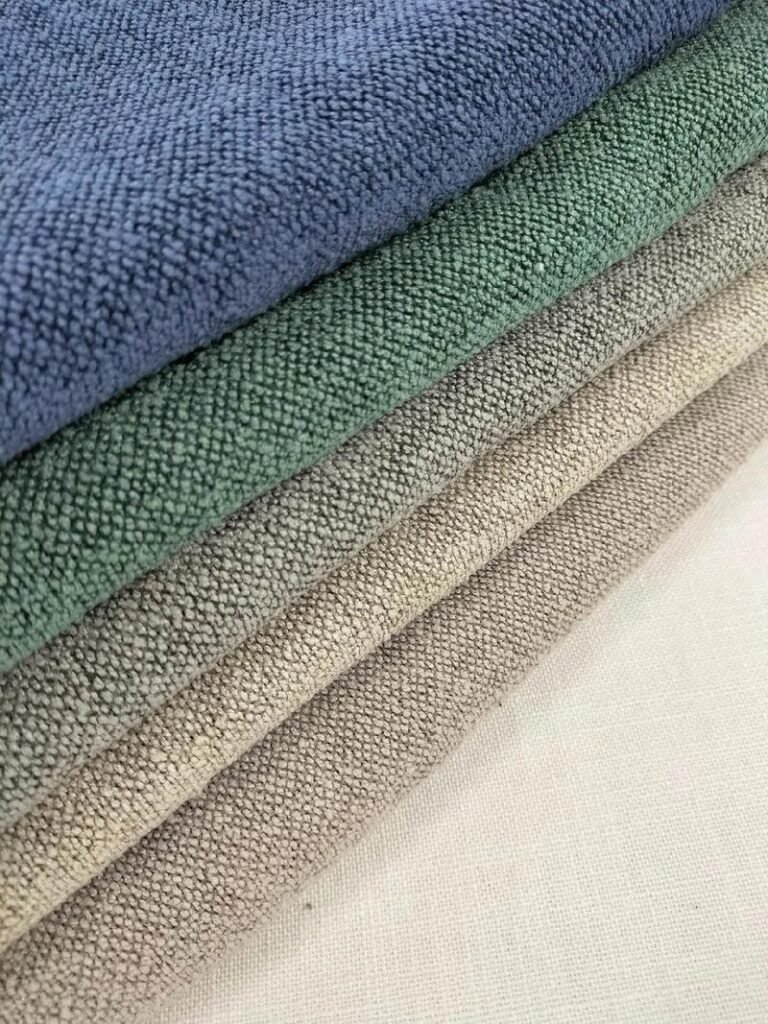
Specialty finishes transform base fabrics into high-performance materials. Waterproofing treatments—such as polyurethane (PU) laminates or durable water repellents (DWR)—create barriers that block over 1,500 mm of water pressure, ideal for rainwear and tents. Flame-retardant (FR) finishes use phosphorus or nitrogen chemistries to pass vertical burn tests (ASTM D6413) with after-flame times under 2 seconds. Antimicrobial coatings incorporate silver ions or quaternary ammonium compounds to achieve > 99% bacterial reduction (AATCC 100), crucial for medical and hospitality textiles. Proper application methods—padding, coating, or lamination—ensure durability through 20–50 home or industrial wash cycles.
Application Methods and Performance Trade-Offs
A. Waterproofing
Methods:
- Lamination: Bonding a thin PU or PTFE membrane to the fabric’s back.
- DWR Coating: Spraying or padding fluorocarbon or silicone finishes onto the face.
Performance:
- Hydrostatic Head: PU laminates ≥ 3,000 mm; DWR finishes ≥ 1,500 mm.
- Breathability: Laminates 5,000 g/m²·24 h; DWR negligible impact (<5% reduction).
Use Cases: Outdoor jackets, tents, awnings.
B. Flame Retardancy
Methods:
- Reactive FR Finish: Covalently bonds phosphorus groups to cotton cellulosics.
- Additive FR Finish: Applied via padding; relies on resin matrices.
Performance:
- Vertical Burn (ASTM D6413): After-flame < 2 s; char length < 50 mm.
- Wash Durability: Reactive finishes retain FR through ≥ 50 industrial washes; additives decline by 30–50% after 20 cycles.
- Use Cases: Welding curtains, stage drapes, protective workwear.
C. Antimicrobial Treatments
Methods:
- Pad-Dry-Cure: Impregnates fabric with silver-ion or QAC solutions, then heat-sets.
- Microencapsulation: Encases biocides in polymer shells for controlled release.
Performance:
- Bacterial Reduction (AATCC 100): ≥ 99% for E. coli and S. aureus.
- Durability: 90–95% efficacy after 30 home launderings.
- Use Cases: Hospital linens, activewear, food-service textiles.
Specialty Finish Comparison
| Finish Type | Application Method | Key Metric | Durability (Washes) | Trade-Off |
|---|---|---|---|---|
| PU Lamination | Heat-press lamination | Hydrostatic head ≥ 3,000 mm | 50+ (industrial) | ↓ Breathability (-20%) |
| DWR Coating | Padding/Spraying | Hydrostatic head ≥ 1,500 mm | 20–30 (home) | Minimal breathability impact |
| Reactive FR | Pad-Dry-Cure | After-flame < 2 s (ASTM D6413) | 50+ (industrial) | Requires precise pH control |
| Additive FR | Padding/Spraying | After-flame < 2 s (ASTM D6413) | 20 (home) | ↓ Soft hand feel |
| Antimicrobial | Pad-Dry-Cure/Encap™ | ≥ 99% bacterial reduction (AATCC100) | 30 (home) | Potential skin sensitivity |
Critical Perspectives
- Breathability vs. Protection Lamination offers top-tier waterproofing but cuts breathability; DWR retains airflow but may need reapplication.
- Durability vs. Hand Feel Reactive FR finishes maintain softness over many washes, unlike additive FRs that stiffen fabrics over time.
- Health & Regulatory Considerations Ensure antimicrobial agents meet EPA or EU Biocidal Product Regulation to avoid regulatory issues.
- Environmental Impact Choose PFAS-free DWRs and formaldehyde-free FRs to minimize ecological and health concerns.
Do Regional Sourcing Considerations—Lead Times, Tariffs, and Certification Standards—Significantly Affect Fabric Selection?
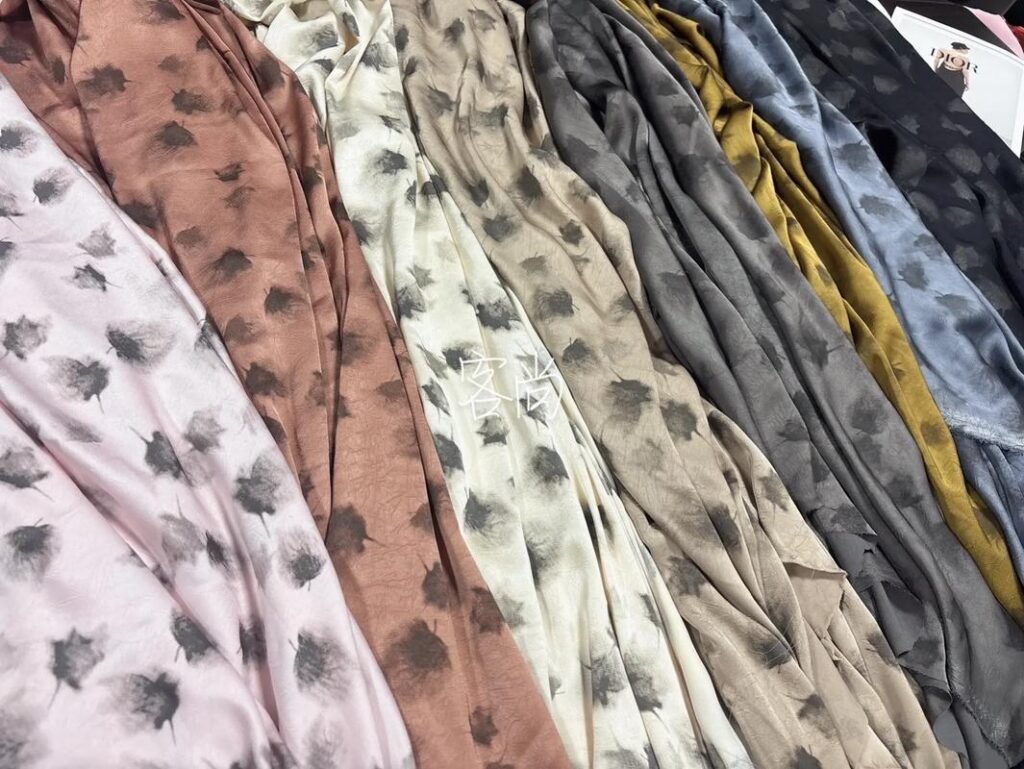
For sourcing managers, where you buy can be as crucial as what you buy. Lead times can range from 2–4 weeks for stocked fabrics in nearby markets to 12–16 weeks for custom orders from overseas mills. Tariffs and trade agreements can add 5–25% to landed costs, while regional certification requirements—OEKO-TEX®, GOTS for organics, REACH in Europe—dictate acceptable chemical usage and social compliance. Balancing cost, speed, and compliance ensures you select fabrics that meet both operational and ethical standards.
Navigating Regional Supply Dynamics
A. Lead Time and Inventory Strategy
- Domestic vs. Offshore: Domestic mills often offer 2–4 week turnaround on stocked items; offshore custom runs require 12–16 weeks.
- Buffer Stock: Maintaining 2–3 months of safety stock reduces stockouts but increases working capital.
B. Tariffs, Duties, and Trade Agreements
- Tariff Rates: Cotton yarns may incur 0–5% tariffs, synthetics 5–15%, blends up to 25% under certain HS codes.
- Free Trade Zones: Sourcing from FTAs (e.g., USMCA, RCEP) can eliminate or reduce duties if origin rules are met.
C. Certification and Compliance
- OEKO-TEX® Standard 100: Ensures absence of harmful substances—critical for apparel and children’s textiles.
- GOTS (Global Organic Textile Standard): Mandates organic fiber content (≥70%) and fair-trade practices—key in sustainable sourcing.
- REACH & Prop 65: European and California regulations restrict specific chemicals; non-compliance can halt imports.
D. Logistics and Risk Management
- Port Congestion: Delays—up to 4 weeks—at major ports (e.g., LA/Long Beach) require alternative shipping plans.
- Supplier Audits: Regular social and quality audits mitigate ethical risks and ensure consistent fabric quality.
Regional Sourcing Factors by Geography
| Region | Typical Lead Time | Tariff Range (%) | Key Certifications | Logistics Risks |
|---|---|---|---|---|
| China | 12–16 weeks | 5–15 | OEKO-TEX®, REACH | Port congestion, language |
| India | 10–14 weeks | 5–10 | GOTS, Fair Trade | Infrastructure, quality variance |
| Turkey | 4–8 weeks | 0–5 | OEKO-TEX®, REACH | Currency fluctuations |
| USA | 2–4 weeks | 0–5 | USDA Organic, Prop 65 | Higher labor cost, capacity constraints |
| Vietnam | 8–12 weeks | 5–20 | OEKO-TEX®, BSCI | Regulatory changes |
Critical Perspectives
- Cost vs. Speed Trade-Off Paying a 5–10% premium for domestic stock can save months of lead time—vital during product launches.
- Certification Premiums Organic and chemical-safe certifications often add 10–20% to fabric cost but unlock premium markets and reduce compliance risk.
- Diversifying Suppliers Spreading orders across regions insulates against geopolitical or logistical disruptions but increases management complexity.
- Total Landed Cost Analysis Always calculate total landed cost—including tariffs, duties, freight, and insurance—to make informed sourcing decisions.
Are There Emerging Sustainable Materials and Innovative Textile Technologies That Sourcing Managers Should Prioritize?
The textile industry’s future is woven from sustainability and innovation. Bio-based fibers like Lyocell (TENCEL™), recycled PET canvases, and plant-based PHA polymers reduce environmental impact, while digital printing, laser cutting, and 3D knitting enable on-demand production with minimal waste. Embracing these advancements helps sourcing managers meet consumer demand for eco-friendly products without sacrificing performance or cost-effectiveness.
Spotlight on Next-Generation Textiles
A. Lyocell and Modal Fibers
- Properties: Biodegradable, closed-loop production uses non-toxic solvent; moisture regain \~13%.
- Applications: High-end apparel, bedding, and medical textiles.
B. Recycled Polyester and Nylon
- Impact: Cuts CO₂ emissions by 30–50% versus virgin; maintains 90% of original tensile strength.
- Uses: Activewear, outdoor gear, upholstery.
C. Plant-Based Polymers (PHA, PLA)\\
- Biodegradability: Industrial compost in 6–12 months; performance approaching conventional synthetics.
- Challenges: Higher cost (20–30% premium) and limited large-scale availability.
D. Digital Fabric Printing\\
- Efficiency: Reduces water use by 80% vs. screen printing; enables small-batch or custom runs.
- Adoption: Fashion, home décor, technical labeling.
E. 3D Knitting and Seamless Technology
- Benefits: Zero-waste patterns, integrated zonal functionality (compression, ventilation).
- Ideal For: Hosiery, technical sportswear, custom upholstery.
Emerging Textile Innovations
| Technology/Fiber | Sustainability Benefit | Performance Trait | Adoption Stage |
|---|---|---|---|
| Lyocell (TENCEL™) | Closed-loop, low water use | Softness, moisture management | Mature |
| Recycled PET/Nylon | 30–50% lower CO₂ emissions | High strength retention | Widely adopted |
| PHA/PLA Polymers | Biodegradable (6–12 mo) | Comparable stretch/strength | Early commercial |
| Digital Printing | -80% water use | Unlimited color options | Rapid growth |
| 3D Knitting | Zero-waste patterning | Custom fit, zonal control | Growing |
Critical Perspectives
- Cost vs. Consumer Demand Eco-fabrics often command higher prices—brands must balance margin with market positioning.
- Supply Chain Maturity Early-stage fibers like PHA face scale-up challenges; partner with innovators to secure supply.
- Technology ROI Investing in digital printing or 3D knitting equipment yields long-term waste reduction but requires capital and training.
- Regulatory Foresight Anticipate future restrictions on PFAS, microplastics, and energy-intensive fibers when planning long-term sourcing strategies.
Navigating the fabric universe—from classic cotton to cutting-edge PHA—demands data-driven choices, strategic supplier partnerships, and an eye toward sustainability. Whether you need soft linens for home textiles, rugged synthetics for technical gear, or innovative bio-fibers for next-gen products, Szoneier Fabrics is your partner in custom solutions.
- Request free fabric swatches and performance data
- Explore low-MOQ prototyping for new materials
- Obtain competitive quotes with rapid sample turnarounds
Contact Szoneier today to align your sourcing strategy with market-leading fabrics and technologies—let’s craft your next success story!

